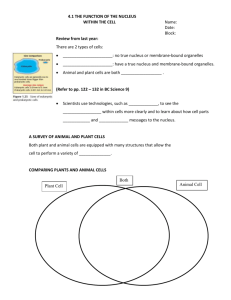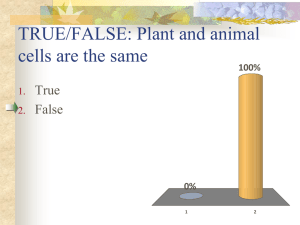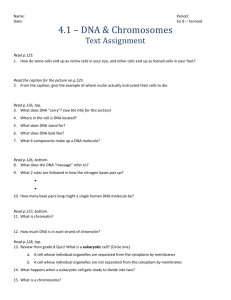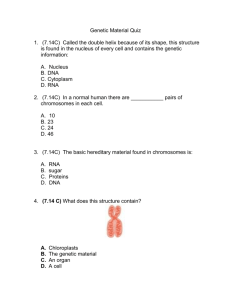File
advertisement
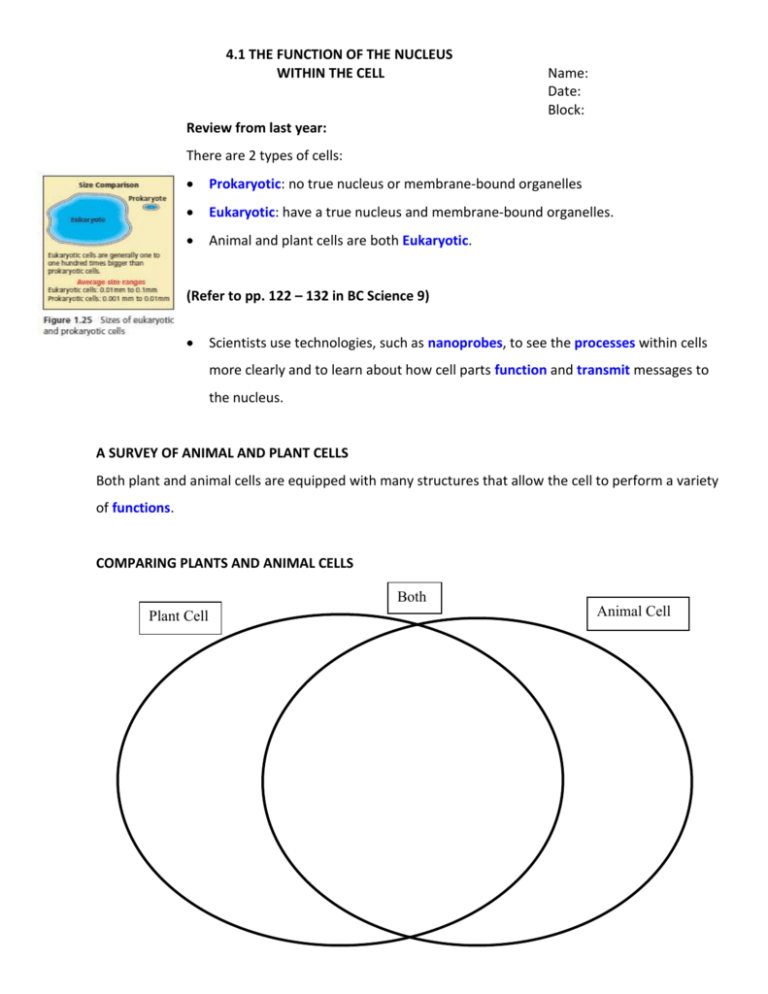
4.1 THE FUNCTION OF THE NUCLEUS WITHIN THE CELL Name: Date: Block: Review from last year: There are 2 types of cells: Prokaryotic: no true nucleus or membrane-bound organelles Eukaryotic: have a true nucleus and membrane-bound organelles. Animal and plant cells are both Eukaryotic. (Refer to pp. 122 – 132 in BC Science 9) Scientists use technologies, such as nanoprobes, to see the processes within cells more clearly and to learn about how cell parts function and transmit messages to the nucleus. A SURVEY OF ANIMAL AND PLANT CELLS Both plant and animal cells are equipped with many structures that allow the cell to perform a variety of functions. COMPARING PLANTS AND ANIMAL CELLS Both Plant Cell Animal Cell PLANT CEL THE NUCLEUS: CONTROL CENTRE OF THE CELL The nucleus contains DNA. DNA is the molecule has the master set of instructions for: what a cell will produce, how it will function, what it will become and when it will die. DNA carries the master set of instructions for cell function Instructions in the nucleus are carried in long, two-stranded molecules called deoxyribonucleic acid (DNA). DNA looks like a twisted ladder - two strands wrap around each other in a spiral shape. The sides of the DNA ladder are made of sugar and phosphate. The steps of the ladder are made of four nitrogenous bases: Adenine (A), Guanine (G), Cytosine (C), and Thymine (T). The arrangement of bases in DNA directs all cell activities Everything that occurs within a cell is the result of how bases on the DNA molecule are arranged (the DNA Message). The bases join in a specific way: A always joins with T C always joins with G the order and number of bases can vary greatly within the DNA molecule. In humans, a single DNA molecule can be several million base pairs in length. DNA is stored in chromatin chromatin: a substance within the nucleus that contains DNA and Proteins Within each strand of chromatin is 1 molecule of DNA. When a cell is growing, the DNA is uncoiled and helps in the manufacture of proteins the cell requires. When a eukaryotic cell is ready to divide, chromatin coils tightly into X-shaped Chromosomes. chromosome: a thread-like structure in a cell that carries genes (Coiled and folded DNA) Every organism has a specific number of chromosomes Chromosomes in the nucleus are found in pairs. Most human cells have 46 chromosomes arranged in 23 pairs The 23rd pair determines sex: XX for females and, XY for males Genes are found on chromosomes Gene: small segments of DNA located on a chromosome Genes store the information needed to produce proteins. Arrangement of bases in a gene will usually code to produce a specific protein. Each chromosome can carry thousands of genes, which contain the information to make thousands of proteins. Proteins determine what body cells will become & how they will function All your body cells have the same genes (same amount of genetic information in the 46 chromosomes), but only specific genes are “read” in each cell to produce specific proteins. This produces specialized cells. Specialized cells tissues organs Two types of specialized proteins: 1. enzymes: proteins that help speed up chemical ractions within cells Ex. digestive enzymes like pepsin. 2. hormones: proteins that carry messages to control cellular activities Ex. hormones for growth HOW PROTEINS ARE PRODUCED Protein production in the cell involves several important steps (p. 131): 1. The nucleus receives a chemical signal to make a specific protein. 2. The DNA message for the protein is copied into a small molecule called RNA 3. RNA leaves the nucleus through a nuclear pore. 4. The RNA message is delivered to a ribosome, the ribosome makes the protein. 5. The manufactured protein enters the Endoplasmic Reticulum (ER). 6. A vesicle forms at the end of the ER, and carries the protein to the Golgi body. 7. The Golgi body repackages the protein for transport out of the cell. 8. A vesicle forms off the end of the Golgi body to carry the protein to the cell membrane. 9. The vesicle attaches to the cell membrane, and its protein contents are released out of the cell. A NEW TASK FOR SCIENTISTS Scientists used to think that one gene coded for one protein. But, there are at least 90,000 different proteins in the human genome, but only 25,000 genes in the human body. Scientists are currently researching how one gene can code for more than one protein?
